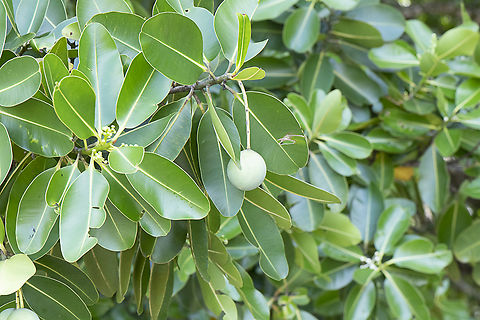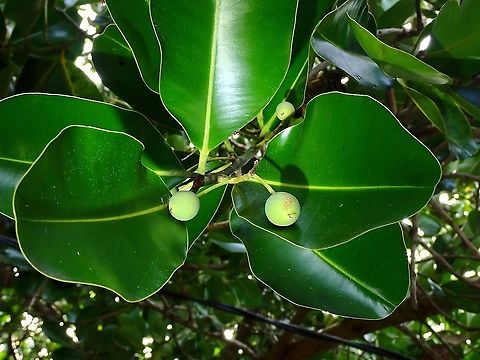
Appearance
"Calophyllum inophyllum" is a low-branching and slow-growing tree with a broad and irregular crown. It usually reaches 8 to 20 m in height. The flower is 25 mm wide and occurs in racemose or paniculate inflorescences consisting of four to 15 flowers. Flowering can occur perennially, but usually two distinct flowering periods are observed, in late spring and in late autumn. The fruit is a round, green drupe measuring 2 to 4 cm in diameter and having a single large seed. When ripe, the fruit is wrinkled and its color varies from yellow to brownish-red.
Naming
"Calophyllum inophyllum" is also known as Alexandrian laurel balltree, beach touriga, Borneo-mahogany, Indian doomba oiltree, Indian-laurel, laurelwood, red poon, satin touriga, and tacamahac-tree. In Island Southeast Asia and Oceania, they are also commonly known as bintangur, bitaog, tamanu, or kamani.Distribution
"Calophyllum inophyllum" is native to Africa in: Comoros; Kenya; Madagascar; Mauritius; Mozambique; Seychelles; Tanzania; south, southeast and east Asia in: Bangladesh; Cambodia; China; southern India; Andaman and Nicobar Islands Indonesia; Japan; Malaysia; Myanmar; Papua New Guinea; the Philippines; Sri Lanka; Taiwan; Thailand; Vietnam; the northwestern, southwestern and south central Pacific Region in: the Cook Islands; Fiji; French Polynesia; Guam; the Marshall Islands; Micronesia; the Northern Mariana Islands; Palau; and Samoa; and in Australia in: Northern Territory and Queensland.Now, it is widely cultivated in all tropical regions of the world. Because of its decorative leaves, fragrant flowers, and spreading crown, it is best known as an ornamental plant.
This tree often grows in coastal regions, as well as nearby lowland forests. However, it has also been cultivated successfully in inland areas at moderate altitudes. It tolerates varied kinds of soil, coastal sand, clay, or even degraded soil.
Habitat
"Calophyllum inophyllum" is native to Africa in: Comoros; Kenya; Madagascar; Mauritius; Mozambique; Seychelles; Tanzania; south, southeast and east Asia in: Bangladesh; Cambodia; China; southern India; Andaman and Nicobar Islands Indonesia; Japan; Malaysia; Myanmar; Papua New Guinea; the Philippines; Sri Lanka; Taiwan; Thailand; Vietnam; the northwestern, southwestern and south central Pacific Region in: the Cook Islands; Fiji; French Polynesia; Guam; the Marshall Islands; Micronesia; the Northern Mariana Islands; Palau; and Samoa; and in Australia in: Northern Territory and Queensland.Now, it is widely cultivated in all tropical regions of the world. Because of its decorative leaves, fragrant flowers, and spreading crown, it is best known as an ornamental plant.
This tree often grows in coastal regions, as well as nearby lowland forests. However, it has also been cultivated successfully in inland areas at moderate altitudes. It tolerates varied kinds of soil, coastal sand, clay, or even degraded soil.
Uses
Aside from shipbuilding, tamanu oil extracted from the fruit kernels were important in Polynesian culture. The oils, as well as poultices made from leaves and flowers, are also commonly used for traditional medicine. The leaves contain compounds that are poisonous to fish and can be used as fish poison. The sap of the tree is poisonous and is used to make poison arrows in Samoa. The mature fruit is poisonous enough to use as rat bait.The seeds yield a thick, dark green tamanu oil for medicinal use or hair grease. The nuts are dried before cracking, after which the oil-laden kernel is removed and further dried. The first neoflavone isolated from natural sources was calophyllolide from "C. inophyllum" seeds.
The Mavilan, a Tulu-speaking tribe in north Kerala in India, use the bark to make a powder that they mix with water and apply it to plants affected by a type of plant disease caused by water that they call "neeru vembu".
The fatty acid methyl esters derived from "C. inophyllum" seed oil meets the major biodiesel requirements in the United States, and European Union. The average oil yield is 11.7 kg-oil/tree or 4680 kg-oil/hectare. In the northwest coastal areas of Luzon island in Philippines, the oil was used for night lamps. This widespread use started to decline when kerosene became available, and later on electricity. It was also used as fuel to generate electricity to provide power for radios during World War II.
References:
Some text fragments are auto parsed from Wikipedia.